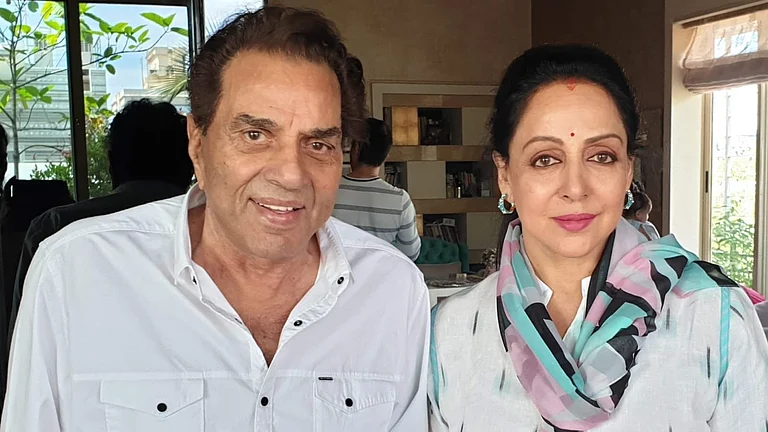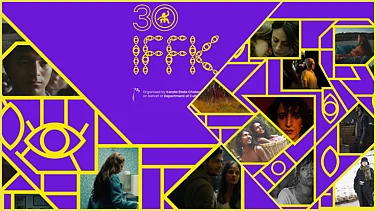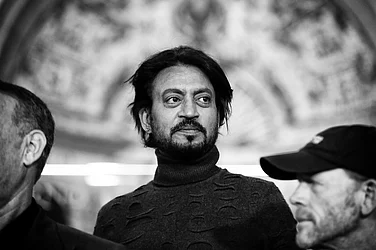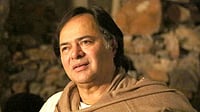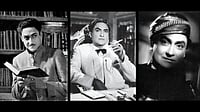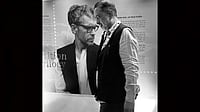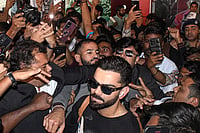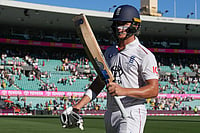
Sholay was released on August 15, 1975, less than two months after the declaration of Emergency.
It received a shockingly cold reception from critics during its first screening.
It was the highest grossing Indian movie until 1982.
What can you say about Sholay which hasn’t already been said, heard, read and written? Well, for one, the cult classic is 50 today. We raised a toast to it when it turned 10… 20… 30… 40. And several years in between too. Still, a 50th birthday is a milestone for Ramesh Sippy’s curry western, which stormed the theatres on August 15, 1975.
The date is historic—not just because it is India’s Independence Day, but also because, less than two months earlier, on June 25, Emergency had been imposed by then Prime Minister Indira Gandhi, subjecting the film to stringent censorship.
The expectations from the film, too, were historic, with posters boldly announcing, “The greatest star cast ever assembled! The greatest story ever told!” Director Ramesh Sippy, still in his twenties, had pulled off a coup, when he convinced his Seeta Aur Geeta (1972) stars, Hema Malini, Dharmendra and Sanjeev Kumar, to put their trust in him a second time.
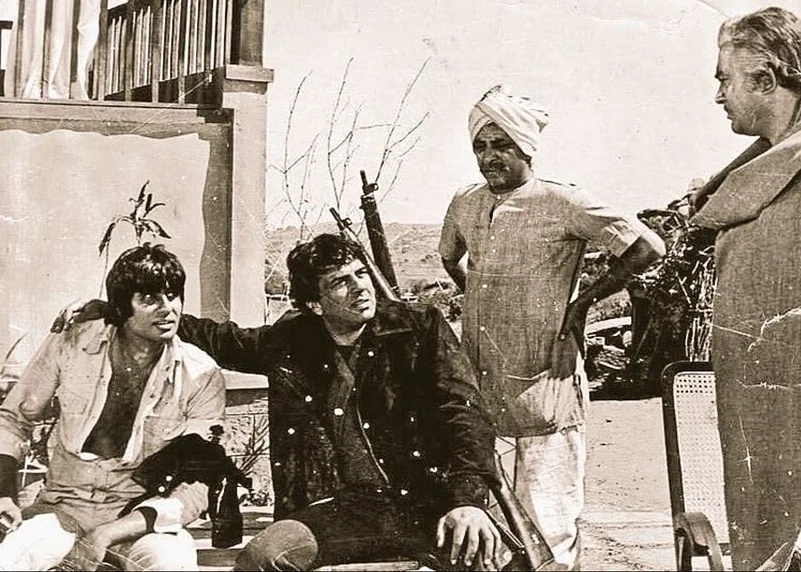
Over the years, one has heard careless whispers that Hema wasn’t too thrilled about playing a chatty, conventional heroine after the ‘brave’ widow in Andaz (1971) and the author-backed, double role in Seeta Aur Geeta. It was said that Sanjeev Kumar, too, was more keen to experiment with a villain’s role—that of Gabbar Singh—which had also caught Dharmendra’s fancy; he was angling for Thakur Baldev Singh. However, when I had posed the question to Garam Dharam and wondered if the rumour was true, he retorted, “Why would I want to play anyone else!” Pointing out that Veeru is boisterous and flamboyant, a role written for him, he had added with a grin, “And I had Hema as my Basanti too!”
Their love blossomed on the sets of Seeta Aur Geeta, bloomed during Sholay, and on May 2, 1980, Dharmendra and Hema Malini tied the knot. It may not have been a happy ending in the film for Jai and Radha, but in real life, Amitabh Bachchan and Jaya Bhadhuri had hurriedly got married on June 3, 1973, so his Babuji, Harivansh Rai Bachchan, would let them to go to London together to celebrate the actor’s first hit, Zanjeer (1973), after 12 consecutive flops. The holiday turned into a honeymoon and four months later, when he drove her to Thakur’s haveli in Ramanagara for the shoot, Jaya was pregnant.
Shweta was born the following year, on March 17. Looking at the new mother’s rounded curves and baby bloom, the director decided to push the schedule forward to give her time to return to the character of the widow beginning to dream again, when tragedy strikes a second time, resulting in her shutting out the world. By the time Sholay premiered, Jaya was pregnant a second time with Abhishek. And Amitabh—who had been desperate for a hit when he signed the film on the strong recommendation of Dharmendra, Salim Khan and Javed Akhtar—was a fast-rising star.

The writer duo gambled not just with this lamba race ka ghoda, but also another dark horse, Amjad Khan. They had recommended him, too, to Sippy, who having seen him in a play with his sister, agreed to meet the actor. Years ago, he confided to me in an interview that looking up at Amjad, as he walked through his office door, his mouth fell open and his first words were, “That’s Gabbar!” The conviction was strengthened when he returned a few days later, in army fatigues, combat boots, a stubble darkening his chin, looking every inch the rugged, menacing daku.
But not everyone was as impressed—and that included the critics, who had been shown a regular 35 mm print, because the much-hyped 70 mm stereophonic prints which had been mixed in London, were stuck at Customs. One critic dismissed the film as a “second-rate take-off on Mera Gaon Mera Desh (1971)” while many other detractors, to this day, list its international muses, from Seven Samurai (1954) and The Magnificent Seven (1960) to Once Upon a Time in the West (1968) and For a Few Dollars More (1965). One even renamed the film “Choley” with “teen maharathis” (Dharmendra, Amitabh Bachchan and Sanjeev Kumar)” and “ek chooha” (Amjad Khan derided for his unusual voice).
In fact, after a shockingly cold reception, there was talk of Gabbar’s voice being dubbed. But fortunately, before that could happen, the film turned a corner and soon, even little kids across the country were mouthing his now iconic dialogue, “Kitney aadmi the?” and “Ab tera kya hoga Kaalia?” in Amjad’s inimitable style.

However, in some centres up North, exhibitors reportedly clipped out some of the lighter scenes featuring Jagdeep’s Soorma Bhopali and Asrani’s Hitlerian Jailor, so the last show would end by midnight, as issued by the newly-issued government diktat. Nevertheless, they were reinstated after the ‘disaster’ became a ‘blockbuster’.
Many of us, perhaps, don’t even know that we have been listening to a truncated version of “Mehbooba O Mehbooba”. Asha Bhosle’s son-in-law Hemant Kenkre remembers listening to RD Burman sing his signature song with an extra antara at stage shows in India and abroad. “I can’t recall the extra lines exactly, and I don’t know if they were ever recorded and filmed, but I have heard them,” he reiterates.
Sholay celebrated silver jubilees in over 100 theatres across India and a record 60 golden jubilees. In Kolkata, its 103-week run at Jyoti cinema ranked second only to Gyan Mukherjee’s Kismet, which in 1943 had drawn audiences to Roxy for 187 straight weeks.

In Mumbai, it enjoyed an uninterrupted 286-week rule at Mumbai’s Minerva cinema, till December 10, 1980, reportedly running on advance booking for the first 75 weeks. It was only in August 2001, that Aditya Chopra’s love story, Dilwale Dulhania Le Jayenge (1995) dislodged Sholay from the charts as India’s longest running film.
It was also the highest grossing Indian film—a record broken only in 1982 by Mithun Chakraborty’s Disco Dancer. It would be another decade before the Salman Khan-Madhuri Dixit starrer Hum Aapke Hain Koun! (1994)—the first film to score a century at the domestic box office displaced Sippy’s epic action-adventure as the highest grossing film in India.
Today, it’s another golden day for a film I’ve watched innumerable times. Each time I watch the train steam into the station, I feel the same excitement and anticipation. And the final shot reminds me of an amusing anecdote the director had shared during an interview in 2015. As they were waiting to take the last shot, an assistant director suddenly remembered that a rose had been tucked in Hema’s hair in the earlier scene. For the sake of continuity, they needed the flower, but it was in a truck which had left to fetch their breakfast. A car was sent behind it, the rose was retrieved and tucked in place, as the train came steaming into the platform. A desolate Veeru gets on, brightens when he sees Basanti waiting in the empty compartment, they embrace, Dwarka Divecha’s camera moving in circles to capture the all-important rose. The train leaves Ramgarh with them and it’s ‘The End’. Phew!
Roshmila Bhattacharya is a senior journalist and the author of four books on cinema.








